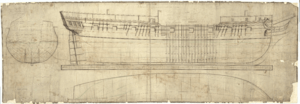HMS Racoon (1808) facts for kids

Racoon
|
|
Quick facts for kids History |
|
|---|---|
| Name | HMS Racoon |
| Ordered | 19 October 1805 |
| Builder | John Preston, Great Yarmouth |
| Laid down | March 1806 |
| Launched | 30 March 1808 |
| Commissioned | June 1808 |
| Reclassified | Convict prison ship in 1819 |
| Fate | Sold 1838 |
| General characteristics | |
| Class and type | Cormorant-class sloop |
| Tons burthen | 425 88⁄94 (bm) |
| Length |
|
| Beam | 29 ft 8+1⁄2 in (9.1 m) |
| Draught | 9 ft (2.7 m) |
| Propulsion | Sails |
| Complement | 121 |
| Armament |
|
HMS Racoon, sometimes spelled HMS Raccoon, was a British warship from the early 1800s. She was an 18-gun ship sloop of the Royal Navy. This means she was a smaller warship with 18 cannons. Built in Great Yarmouth, she was launched on 30 March 1808. Racoon traveled far, even reaching Fort Astoria on the Columbia River in North America. Later, she became a hospital ship in 1819 and was finally sold in 1838.
Contents
Adventures of HMS Racoon
Early Missions and Captures
Racoon's first commander was James Welsh. He sailed her to the coast of Africa. In June 1809, she went to Jamaica. Commander Welsh sadly passed away there in November.
Commander William Black then took command of Racoon. In 1812, the ship returned to Portsmouth, England. On 14 January 1813, Racoon captured a ship named Hope. Even though the enemy later got Hope back, Racoon received a large insurance payment for it.
Journey to the Pacific Ocean
In July 1813, Racoon left Rio de Janeiro in Brazil. She sailed with other British warships, HMS Phoebe and HMS Cherub. They also sailed with a merchant ship called Isaac Todd. Their journey took them around Cape Horn, the southern tip of South America.
The ships were heading to the Juan Fernández Islands. This was a long and challenging voyage.
The Fur Trade Rivalry
The British Royal Navy had a special mission. A company from Montreal called the North West Company wanted them to capture a trading post. This post belonged to their rival, the Pacific Fur Company. The post was called Fort Astoria and was located on the Columbia River.
Captain Frazer Smith of the Isaac Todd had a special permission called a "letter of marque." This allowed his merchant ship to act like a warship and capture enemy vessels. His job was to seize Fort Astoria. However, Isaac Todd was a slow ship and could not keep up with the faster warships.
So, Racoon sailed ahead to Fort Astoria. Meanwhile, Phoebe and Cherub went to search for an American warship, USS Essex. On the way to the Columbia River, Racoon had an accident during gunnery practice. Eight men died and 20 were injured.
Fort Astoria Becomes Fort George
Racoon arrived at Fort Astoria on 30 November 1813. But something surprising had already happened. The North West Company had made a deal with the Pacific Fur Company. The American company sold their assets to the British company for a low price. They did this because they knew British ships were coming to take their American property.
Commander Black found that the matter was already settled. However, he still performed a ceremony to claim the fort for Britain. He then renamed the facility Fort George. The slow Isaac Todd finally arrived much later, on 23 April 1814. She then sailed to China.
A Hawaiian Traveler and Repairs
One person on board Racoon when she reached Fort Astoria was Naukane, also known as John Coxe. He was a Native Hawaiian. The North West Company had hired him as a worker. He was also an interpreter for future visits to the Hawaiian Islands.
After leaving Fort George, Racoon sailed south to San Francisco. From 13 to 19 March 1814, Racoon underwent repairs. These repairs happened on the beach at Ayala Cove. This cove is on the northern part of Angel Island. This event gave the name Raccoon Strait to the deep-water channel between Tiburon and Angel Island. After repairs, Commander Black sailed the ship to Lima, Peru.
Later Commands
In January 1815, Cherub and Racoon left Rio de Janeiro. They were escorting a group of ships. These included supply ships and seven merchant vessels. They left Pernambuco in Brazil on 6 March.
Lieutenant James Mangles was in charge of Racoon for a time in 1815. This was at the Cape of Good Hope in South Africa. Captain Alexander Montgomerie then replaced Commander Black in 1815. Captain John Cook Carpenter was appointed to command in May 1815.
Post-War Life and Final Sale
In January 1817, Racoon was re-rated as a 20-gun sixth rate ship. This meant she was classified as a slightly larger warship. Captain Robert Worgan Festing commanded her in 1817.
Between September and October 1819, Racoon was changed into a convict hospital ship. This work was done in Portsmouth. She stayed in service as a hospital ship for many years. The Navy finally sold her for £820 to a person named Mr. Soames. This happened on 16 August 1838.

